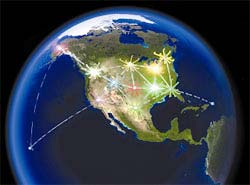Revised Version – Neon Design Consortium And Project Office To Coordinate Design Of Ecological Observatories

NEON’s synthesis, computation and visualization infrastructure will create a virtual laboratory that will allow scientists to develop a predictive understanding of the relationship between environmental change and biological processes. Credit: NSF
The scientific community’s work to create the National Ecological Observatory Network (NEON) enters a new phase today. Bruce Hayden, an ecologist at the University of Virginia and principal investigator for the project, along with William Michener, associate director of NSF’s Long Term Ecological Research (LTER) Network, will direct the NEON project office at the American Institute of Biological Sciences (AIBS) headquarters in Washington, D.C.
With a two-year, $6 million cooperative agreement from NSF, AIBS will set up a NEON Design Consortium and Project Office to develop a blueprint for the network and a plan for its implementation. NEON, envisioned as field and lab instrumentation deployed across the United States and integrated via cutting-edge cyberinfrastructure into a continent-wide research platform, will be the first national ecological observation system designed to answer scientific questions at regional and continental scales to enable ecological forecasting.
“Once built, NEON will transform ecological research.” said Mary Clutter, the assistant director of the directorate for biological sciences. “It will create new collaborative environments—bringing together ecologists, engineers, social, physical, computer, and earth scientists—to investigate ecological phenomena that span large geographical areas and long periods of time.” Clutter believes NEON can also provide unique educational opportunities for students and the public alike. “This award is a major step toward realizing NEON,” she said.
According to Liz Blood, NSF program director for NEON, “The most pressing challenges facing the nation’s biosphere — the impact of climate change on forests and agriculture, the emergence and spread of infectious diseases, and the causes and consequences of invasive species—result from complex interactions between human, natural and physical systems. These systems are large spatially, change over time, and cross all levels of biological organization,” she said. “To better understand them and forecast biological change, ecologists need a new tool to study the structure and dynamics of ecosystems in the United States.”
Just as the nation’s network of meteorological stations allows scientists to predict changes in the weather, NEON will make it possible for scientists to predict changes in the nation’s ecosystems and their consequences, said Hayden. The project, managed at AIBS by science office director, Jeffrey Goldman, is designed to involve large numbers of scientists and educators in the development of the NEON network blueprint and implementation plan.
Media Contact
More Information:
http://www.nsf.govAll latest news from the category: Ecology, The Environment and Conservation
This complex theme deals primarily with interactions between organisms and the environmental factors that impact them, but to a greater extent between individual inanimate environmental factors.
innovations-report offers informative reports and articles on topics such as climate protection, landscape conservation, ecological systems, wildlife and nature parks and ecosystem efficiency and balance.
Newest articles

First-of-its-kind study uses remote sensing to monitor plastic debris in rivers and lakes
Remote sensing creates a cost-effective solution to monitoring plastic pollution. A first-of-its-kind study from researchers at the University of Minnesota Twin Cities shows how remote sensing can help monitor and…

Laser-based artificial neuron mimics nerve cell functions at lightning speed
With a processing speed a billion times faster than nature, chip-based laser neuron could help advance AI tasks such as pattern recognition and sequence prediction. Researchers have developed a laser-based…

Optimising the processing of plastic waste
Just one look in the yellow bin reveals a colourful jumble of different types of plastic. However, the purer and more uniform plastic waste is, the easier it is to…



